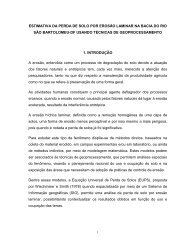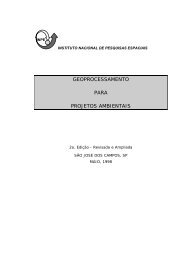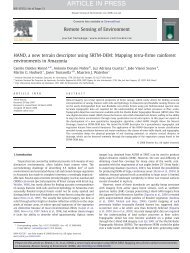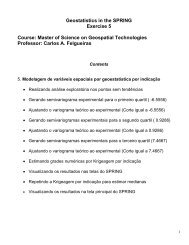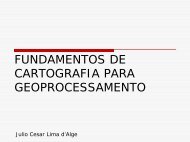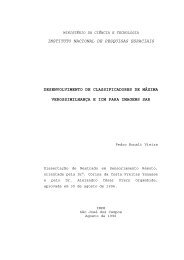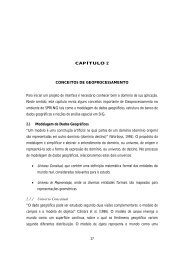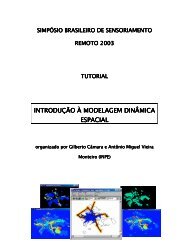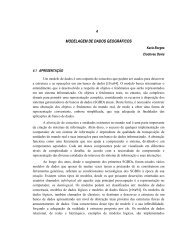GEO GFMS Muchoney - DPI
GEO GFMS Muchoney - DPI
GEO GFMS Muchoney - DPI
You also want an ePaper? Increase the reach of your titles
YUMPU automatically turns print PDFs into web optimized ePapers that Google loves.
Global Earth Observing System of<br />
Systems (<strong>GEO</strong>SS):<br />
Biodiversity, Ecosystems and<br />
<strong>GEO</strong> BON<br />
<strong>GEO</strong> Forest Monitoring Symposium<br />
4 November 2008<br />
Douglas M. <strong>Muchoney</strong>, Ph.D.<br />
U.S. Geological Survey<br />
© <strong>GEO</strong> Secretariat
Trees are so much more<br />
sensible than people, steadier<br />
and more enduring<br />
Emily Carr<br />
© <strong>GEO</strong> Secretariat
<strong>GEO</strong>SS: A Global, Coordinated, Comprehensive<br />
and Sustained System of Observing Systems<br />
© <strong>GEO</strong> Secretariat
<strong>GEO</strong>SS will Address Nine Societal<br />
Benefit Areas<br />
1. Reduction and Prevention of Disasters<br />
2. Human Health and Epidemiology<br />
3. Energy Management<br />
4. Climate Variability & Change<br />
5. Water Management<br />
6. Weather Forecasting<br />
7. Ecosystems<br />
8. Agriculture<br />
9. Biodiversity<br />
© <strong>GEO</strong> Secretariat
The Earth is a complex system of systems<br />
© <strong>GEO</strong> Secretariat
Any Single Problem Requires Many<br />
Data Sets<br />
A Single Data Set Will Serve Many<br />
Communities<br />
© <strong>GEO</strong> Secretariat
© <strong>GEO</strong> Secretariat<br />
Solar Energy
NDVI value<br />
Vegetation greenness profiles<br />
200<br />
180<br />
160<br />
140<br />
120<br />
North America Vegetation Annual Greenness Profiles<br />
100<br />
J F M A M J J A S O N D<br />
month<br />
© <strong>GEO</strong> Secretariat<br />
Northeastern US Deciduous Forest<br />
Corn Belt Agriculture<br />
Pinacate Desert<br />
Southeastern US Pine Forest
SeaWiFS<br />
SeaWinds<br />
QuikScat<br />
ERBS<br />
SORCE<br />
Grace<br />
SPOT 4, 5<br />
Orbview 2, 3<br />
QuickBird<br />
IKONOS<br />
Envisat<br />
Radarsat ALOS<br />
UARS<br />
Jason<br />
Aura/Aqua/Terra<br />
EROS A1<br />
Landsat 7<br />
SPIN-2<br />
DMC<br />
Toms-EP<br />
© <strong>GEO</strong> Secretariat<br />
Space Observation Systems<br />
Sage<br />
CBERS<br />
TRMM<br />
ACRIMSAT
© <strong>GEO</strong> Secretariat<br />
In Situ Observation<br />
Systems
Let’s not forget aerial ….<br />
© <strong>GEO</strong> Secretariat
<strong>GEO</strong> Ecosystems – 2009-11 Work Plan<br />
Objective: to improve the management and protection of terrestrial,<br />
coastal and marine resources<br />
EC-09-01: Ecosystem Observation and Monitoring Network (<strong>GEO</strong><br />
EcoNet)<br />
• Coordinate and improve the observation, characterization and<br />
monitoring of terrestrial (forest, urban agriculture, woodlands,<br />
grasslands, and deserts), freshwater, ice and oceans ecosystems –<br />
especially in terms of acquisition and use of satellite/aerial/in-situ<br />
observation. Develop a global integrated sampling frame in coordination<br />
with the <strong>GEO</strong>SS Geodesy activities.<br />
• a) Ecosystem Classification and Mapping (former EC-06-02)<br />
• b) Ecosystem Status and Trends<br />
• c) Regional Networks for Ecosystems (former EC-06-07)<br />
• d) Protected Areas Assessment and Monitoring (<strong>GEO</strong> PAAM)<br />
© <strong>GEO</strong> Secretariat
<strong>GEO</strong> Ecosystems – 2009-11 Work Plan<br />
EC-09-02: Human Dimension of Ecosystem Utilization<br />
and Conservation<br />
• Identify and assess the risks posed by global change and<br />
human development to the environment, society and<br />
regional economies. Develop adaptation strategies to reduce<br />
these risks and mitigate impacts at local, regional and global<br />
levels.<br />
a) Global Road and Human Settlements Mapping on <strong>GEO</strong><br />
Grid<br />
b) Tourism Impact on Environmental, Social and Economic<br />
Regional Activities<br />
c) Developing Transport Infrastructure in Africa<br />
© <strong>GEO</strong> Secretariat
<strong>GEO</strong> 2009-11 Work Plan – Related Task<br />
DA-09-03: Global Data Sets<br />
a) Global Land Cover (former DA-07-02)<br />
b) Forest Mapping and Change Monitoring (former<br />
AG-06-04)<br />
c) Bio-geophysical & Land Surface Data<br />
d) Global Phenology Data<br />
e) Global DEM (former DA-07-01)<br />
f) Development of Global Map for <strong>GEO</strong>SS Societal<br />
Benefit Areas (former DA-06-05)<br />
© <strong>GEO</strong> Secretariat
<strong>GEO</strong> 2009-11 Work Plan – Related Task<br />
DA-09-05: Global Carbon Observation and Analysis<br />
System<br />
Implement a global carbon observation and analysis system<br />
addressing the three components of the carbon cycle<br />
(atmosphere, land and ocean). Develop robust tools and<br />
methodologies for high-precision CO2 measurements and<br />
carbon storage evaluation.<br />
a) Integrated Global Carbon Observation (IGCO)<br />
(former EC-06-01)<br />
b) Forest Carbon Tracking<br />
Note: This Task is supported by the Carbon Cycle Community of Practice (former<br />
IGCO) and the Forest Community of Practice<br />
© <strong>GEO</strong> Secretariat
<strong>GEO</strong> Ecosystems Classification and Mapping<br />
EC-06-02<br />
© <strong>GEO</strong> Secretariat
• Representation of Paraguayan<br />
terrestrial ecosystems in the<br />
national protected area system<br />
• COP-7/CBD mandates that all<br />
signatory countries implement a<br />
national gap analysis of their<br />
biodiversity<br />
Paraguay: GAP analysis<br />
© <strong>GEO</strong> Secretariat
<strong>GEO</strong> Biodiversity<br />
Objectives: Understanding, monitoring and conserving biodiversity. Issues include<br />
the condition and extent of ecosystems, distribution and status of species, and<br />
genetic diversity in key populations.<br />
BI-07-01: Biodiversity Observation Network (<strong>GEO</strong> BON)<br />
Coordinate and improve biodiversity (animals, plants, genes, etc)<br />
observation, assessment and conservation – especially in terms of<br />
acquisition and use of satellite/aerial/in-situ observation. Develop a<br />
global observation network to facilitate coordination among information<br />
users and providers. Improve the quality and quantity of observation<br />
and advocate for a better understanding of trends and conservation.<br />
a) Biodiversity Observation Network (<strong>GEO</strong> BON)<br />
b) Invasive Species Monitoring System (former BI-07-02)<br />
Note: Activities in the Biodiversity area are supported by the Biodiversity Community of<br />
Practice<br />
© <strong>GEO</strong> Secretariat
<strong>GEO</strong> Biodiversity Community of Practice<br />
Australia, Botswana, Brazil, Canada, Columbia, Denmark,<br />
Estonia, France, Germany, Ghana, Hungary, India, Iran,<br />
Israel, Italy, Japan, Mexico, Namibia, Netherlands,<br />
Nicaragua, Niger, Nigeria, Norway, Panama, Philippines,<br />
Portugal, South Africa, Switzerland, Thailand, Tunisia, UK,<br />
Ukraine, Uruguay, USA, ASEAN Centre for Biodiversity,<br />
BioNET-INTERNATIONAL, BirdLife International,<br />
Conservation International, DIVERSITAS, ESRI, GBIF, Guyra<br />
Paraguay, IUCN, LIFEWATCH, The Nature Conservancy,<br />
UNEP, UNESCO<br />
© <strong>GEO</strong> Secretariat
<strong>GEO</strong> Biodiversity Observation Network<br />
© <strong>GEO</strong> Secretariat
<strong>GEO</strong> Biodiversity Observation Network:<br />
What is it?<br />
• A Network of Networks of Biodiversity Information<br />
Data Providers and Users<br />
• An ecoregion-based framework for global planning and<br />
management applications<br />
• A global data development and analysis effort<br />
• An advisory resource for other networks and processes<br />
like IABIN, the Convention on Biological Diversity, the<br />
Conservation Measures Partnership, the UN Millennium<br />
Development Goals, etc.<br />
© <strong>GEO</strong> Secretariat
<strong>GEO</strong> UIC Community of Practice Structure<br />
<strong>GEO</strong><br />
Water Health Climate Energy Weather Bio Ag Eco Disaster<br />
Invasives<br />
Species<br />
Data<br />
© <strong>GEO</strong> Secretariat<br />
<strong>GEO</strong> BON<br />
All Tasks<br />
Ecosystem<br />
Net<br />
Protected<br />
Areas
© <strong>GEO</strong> Secretariat
Diversitas GBIF<br />
Diversitas<br />
Network<br />
<strong>GEO</strong> BON Network of Networks<br />
GBIF<br />
Network<br />
Integration Line<br />
<strong>GEO</strong><br />
<strong>GEO</strong> BON<br />
UNEP<br />
WCMC<br />
WCMC<br />
Network<br />
© <strong>GEO</strong> Secretariat<br />
IUCN Birdlife<br />
IUCN<br />
Network<br />
BirdLife<br />
Network
Invasives<br />
<strong>GEO</strong><br />
Species<br />
Data<br />
Bio Eco<br />
<strong>GEO</strong> BON<br />
All<br />
Tasks<br />
Portals Modelers Search Engines<br />
NISbase<br />
Ecosystem<br />
Net<br />
Protected<br />
Areas<br />
Users<br />
GISIN Portal<br />
Other Invasive<br />
Databases<br />
End-Users<br />
(Decision-makers,<br />
Public)<br />
GISIN Registry<br />
hosted by GBIF<br />
© <strong>GEO</strong> Secretariat<br />
Emerging GISIN Information System<br />
Based on graphic by Jim Graham<br />
Herbariums Museums<br />
http://www.niiss.org/gisin<br />
Consumers<br />
(Clients)<br />
GISIN system<br />
(Web services)<br />
Providers<br />
(of Data)
© <strong>GEO</strong> Secretariat
Dr. Lori Daniels, UBC<br />
7 plots<br />
British Columbia<br />
Stephenson, van Mantgem, et al., USGS<br />
27 plots<br />
California<br />
© <strong>GEO</strong> Secretariat<br />
John Byrne, USFS<br />
8 plots<br />
Idaho<br />
US Forest Service FIA plots?<br />
>10,000 plots<br />
Everywhere<br />
Dr. Tom Veblen, U. of Colorado<br />
>40 plots?<br />
Colorado<br />
National Park Service FMH plots<br />
>1000 plots?<br />
Western national parks<br />
USFS, Gus Pearson forest<br />
1 huge plot<br />
Arizona
The CTFS plot network<br />
http://www.ctfs.si.edu/<br />
(130 to 1780 m elevation; mean = 715 m)<br />
Dr. D. Lieberman et al.<br />
Plots measured<br />
1969 to 1985?<br />
(32 to 71 m elevation)<br />
Some examples from South America:<br />
The RAINFOR plot network<br />
http://www.geog.leeds.ac.uk/projects/rainfor/<br />
(35 to 800 m elevation; mean = 250 m)<br />
© <strong>GEO</strong> Secretariat<br />
Prof. J. P. Veillon et al.<br />
Plots measured 1961 to 1985?<br />
(2450 m elevation)<br />
Prof. A. J. Duque M. et al.<br />
Plots are being established<br />
(~0 to ~3000 m elevation)
GBIF Interoperability Scenario<br />
• Scenarios for interoperability between Biodiversity and<br />
Climate SBAs<br />
• Relevancy<br />
– Climate change threatens to commit 15-37% of species to extinction<br />
by 2050.<br />
– Widespread land use changes are accelerating the mass extinction.<br />
– The theme for the International Day for Biological Diversity (IBD) in<br />
2007<br />
– Report of the Intergovernmental Panel on Climate Change<br />
© <strong>GEO</strong> Secretariat
Species Response to Climate Change<br />
• Ecological Niche Modeling is applied to study the adaptation of<br />
butterflies in Canada and Alaska to various climate change scenarios.<br />
– The scientific approach for using primary biodiversity data for studying<br />
adaptation to various climate change scenarios has been created by<br />
Peterson & al. (2001, 2002).<br />
• Requires interoperability between the GBIF (Global Biodiversity<br />
Information Facility) and components of the WIS (World Meteorological<br />
Organization Information System).<br />
© <strong>GEO</strong> Secretariat
Interoperability with GBIF and climatological<br />
registries<br />
• Mediation Metadata Model: ISO 19115 core profile<br />
Access<br />
GBIF<br />
Registry<br />
GI-cat/GI-go<br />
In-situ<br />
Biodiversity<br />
Records<br />
Discovery Access<br />
WCS<br />
Registry<br />
© <strong>GEO</strong> Secretariat<br />
Climatological<br />
and<br />
Environmental Data
Demonstrator user interface<br />
• Demo AJAX Graphical User Interface to: Open Modeller Compute<br />
Servers and GI-cat/GI-go<br />
© <strong>GEO</strong> Secretariat
<strong>GEO</strong> BON Milestones<br />
2006: User Needs workshop, Geneva 23-25 October<br />
2007: <strong>GEO</strong> Ministerial in Cape Town<br />
2008:<br />
– Interim <strong>GEO</strong> BON Committee formed 14-16<br />
January<br />
– Draft <strong>GEO</strong> BON concept document produced<br />
– 2 nd International workshop, Potsdam/Berlin 8-<br />
10 April<br />
– Draft <strong>GEO</strong> BON concept document discussed and<br />
amended, first implementation steps planned<br />
– Science Forum article<br />
– Biostrat Workshop – Budapest, 25-26 Oct. 2008<br />
– <strong>GEO</strong> BON Implementation Plan, October 2008<br />
– <strong>GEO</strong> Forest Monitoring Symposium, Iguacu Falls,<br />
Brazil, 4-7 November 2008<br />
– <strong>GEO</strong> Plenary, Bucharest, 17-19 November 2008<br />
2009: 3rd <strong>GEO</strong> BON Meeting<br />
© <strong>GEO</strong> Secretariat
<strong>GEO</strong> BON Implementation Plan Work Groups<br />
1. Data: focuses on issues, primarily technical ones, relating to data, the<br />
systems that store and serve it, and how those systems communicate.<br />
2. Network and Governance Task Group: charged with creating the<br />
approach for developing and governing the data provider network.<br />
3. Scaling, Integration, and Models: focuses on the issues associated<br />
with data integration across multiple scales.<br />
4. Early Products Task Group: mandate to select a small number of pilot<br />
projects that generate new, added-value <strong>GEO</strong> BON products.<br />
5. Capacity Building: develop a plan to increase capacity where it is<br />
needed to support <strong>GEO</strong> BON activities and goals.<br />
6. Citizen Science: ways to work with interested citizens as a means of<br />
providing useful scientific observations.<br />
7. Resources and Business Plan Task Group: devise a business plan for<br />
<strong>GEO</strong> BON<br />
© <strong>GEO</strong> Secretariat
Douglas M. <strong>Muchoney</strong>, Ph.D.<br />
U.S. Geological Survey<br />
dmuchoney@usgs.gov<br />
© <strong>GEO</strong> Secretariat<br />
Thank<br />
You!



